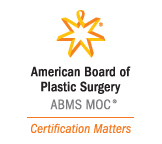
Reduce the burden of over-sized breasts.
Breast reduction (reduction mammoplasty) surgery is a physically and emotionally transformative procedure that reduces the size and weight of large, heavy breasts. By removing excess tissue, fat, and sagging skin, our skilled and experienced surgeons at Plastic Surgery of Westchester can relieve you of the discomfort caused by overly heavy breasts; and create an aesthetically pleasing, symmetrical, and well-proportioned breast size, contour, and shape, to suit your body frame and preferences.
Breast Reduction benefits
Breast reduction surgery offers life-changing benefits, including relief from chronic back, neck, and shoulder pain, improved posture, and enhanced physical mobility. It eliminates skin irritation, reshapes sagging breasts for a more youthful appearance, and boosts confidence by creating better proportion and symmetry. Patients enjoy greater comfort in daily activities, expanded clothing options, and long-term health benefits like easier mammograms and reduced risk of posture-related issues. Overall, it significantly improves quality of life by alleviating physical discomfort and enhancing self-esteem.
Large, heavy breasts place constant strain on the upper body, leading to persistent back, neck, and shoulder pain. Over time, this can cause muscle tension, spinal misalignment, and even chronic conditions like kyphosis (rounded upper back). Breast reduction removes excess weight, significantly reducing or eliminating discomfort and allowing for a more comfortable, pain-free daily life.
The weight of disproportionately large breasts forces many women to hunch forward to compensate, leading to poor posture and long-term spinal stress. After surgery, patients often stand taller with better spinal alignment, reducing the risk of degenerative disc issues and improving overall body mechanics.
Oversized breasts can make exercise uncomfortable or even painful, discouraging activities like running, yoga, or high-impact workouts. Post-reduction, women report greater freedom of movement, increased stamina, and the ability to participate in sports without restrictive sports bras or discomfort.
Constant friction beneath heavy breasts can cause chronic skin breakdown, rashes (intertrigo), and infections in the breast fold. By reducing breast size and improving skin-to-skin contact, patients experience fewer skin issues, less sweating, and easier hygiene maintenance.
Large breasts often sag (ptosis) unevenly, leading to asymmetry and an aged appearance. A breast reduction lifts and reshapes the breasts for a more youthful, balanced contour, with nipples repositioned for a natural look. Many women feel more confident in swimsuits and fitted clothing.
Women with overly large breasts often struggle with unwanted attention, difficulty finding clothes, or self-consciousness. After surgery, many report feeling more proportional, feminine, and comfortable in their bodies, leading to improved social interactions and mental well-being.
The weight of large breasts can strain neck muscles and compress nerves, leading to tension headaches or tingling in the arms. By removing excess breast tissue, many patients experience fewer headaches and relief from nerve-related symptoms.
Heavy breasts can make it hard to find a comfortable sleeping position, causing shoulder pain or restricted breathing. After reduction, patients often sleep better on their back or side without discomfort, leading to more restful nights.
Beyond immediate relief, breast reduction can lower risks of chronic pain, arthritis, and spinal degeneration caused by poor posture. It also simplifies breast cancer screenings, as smaller breasts make mammograms and self-exams easier and more accurate.
Who is a good candidate for Breast Reduction?
A good candidate for breast reduction surgery is typically a healthy, non-smoking individual with fully developed breasts who experiences physical discomfort (chronic back/neck pain, skin irritation, or posture problems) or emotional distress due to overly large breasts. Ideal patients have realistic expectations, are at a stable weight, and seek relief from symptoms that limit daily activities or exercise. Women planning future pregnancies may delay surgery, as breastfeeding ability can be affected. A consultation with a board-certified plastic surgeon determines candidacy based on medical history, breast composition, and individual goals.
Breast Reduction techniques
Inferior Pedicle (Anchor/Inverted-T) Technique
This method is ideal for moderate to large breast reductions. The surgeon makes an anchor-shaped incision around the areola, vertically down the breast, and along the natural crease. Excess tissue is removed while preserving the nipple’s blood and nerve supply by keeping it attached to a pedicle (a bridge of tissue). This technique ensures reliable nipple sensation and allows for significant reshaping, but it leaves more noticeable scarring compared to other methods.
Vertical (Lollipop) Technique
Designed for small to moderate reductions, this approach involves a lollipop-shaped incision around the areola and straight down to the breast fold, eliminating the horizontal scar found in the anchor technique. It provides a natural lift with less scarring and a quicker recovery. However, it may not be suitable for very large breasts requiring extensive tissue removal.
Liposuction-Only Reduction
Best for minor reductions in breasts composed primarily of fat (rather than dense glandular tissue), this technique uses liposuction to remove excess fat without surgical excision or significant scarring. Recovery is fast, but since no skin is removed, there’s no lifting effect, and the reduction is limited.
Free Nipple Graft Technique
Reserved for extremely large breasts (gigantomastia), this method involves detaching the nipple and areola completely before reattaching them as a skin graft. It allows for the most dramatic reduction but permanently eliminates nipple sensation and the possibility of breastfeeding.
Short-Scar (Circumareolar) Technique
Used for minor reductions or lifts, this technique involves only a circular incision around the areola. Scarring is minimal, but the amount of tissue that can be removed is limited, making it less effective for significant size reduction.
Your initial Breast Reduction consultation
During your initial breast reduction consultation, the surgeon will review your medical history, assess your breast size, shape, and skin quality, and discuss your goals to determine the best surgical approach. They’ll perform a physical exam—measuring breast volume, evaluating tissue composition, and checking for asymmetry—before recommending a technique (like the anchor or lollipop method) tailored to your needs. You’ll see before-and-after photos, learn about potential risks (scarring, sensation changes), and discuss logistics, including cost, insurance coverage (if applicable), and pre-op instructions. The consultation ensures you understand the procedure, recovery, and expected outcomes, helping you make an informed decision. Bring any questions and wear a supportive bra for accurate assessment.
Breast Reduction pre-procedure preparation
Pre-procedure preparation for breast reduction surgery involves several key steps to ensure safety and optimal results. Patients should undergo medical evaluations, including blood tests and possibly a mammogram, and disclose all medications/supplements to avoid bleeding risks (e.g., stopping aspirin or anti-inflammatories 2 weeks prior). Smoking must cease at least 4–6 weeks before surgery to promote healing. Arrange for a responsible adult to assist with transportation and post-op care, and prepare a recovery space with loose, front-opening clothing and essentials at waist level. Follow fasting instructions (no food/water 8–12 hours before anesthesia) and shower with antibacterial soap the night before/morning of surgery. Lastly, discuss final questions with the surgeon and confirm logistics like arrival time and prescriptions.
Breast Reduction recovery
Recovery from breast reduction surgery typically involves 1–2 weeks of downtime, with gradual improvement over 4–6 weeks. Immediately post-op, you’ll wear a surgical bra to minimize swelling and support healing, with mild to moderate discomfort managed by prescribed pain medication. Drainage tubes (if used) are removed within a few days, and stitches dissolve or are removed in 1–2 weeks. Swelling and bruising subside within 2–3 weeks, but avoid strenuous activity, heavy lifting, or raising arms overhead for 4–6 weeks to prevent strain. Most patients return to light work after 1–2 weeks, though full recovery (including scar fading and final breast shape settling) may take 3–6 months. Follow-up appointments ensure proper healing, and scars can be managed with silicone treatments. Adhering to your surgeon’s guidelines—like sleeping on your back and avoiding underwire bras early on—optimizes results.
Breast Reduction results
Breast reduction surgery delivers transformative results, offering both functional and aesthetic improvements. Patients typically experience immediate relief from physical discomfort—such as back, neck, and shoulder pain—while achieving a lighter, more proportionate breast size that enhances mobility and posture. The breasts appear uplifted, symmetrical, and naturally contoured, with reduced sagging and improved nipple positioning. Scars fade over time (though never fully disappear) and are strategically placed to be discreet. Clothing fits better, exercise becomes easier, and many report a boost in confidence due to their balanced silhouette. Final results settle within 3–6 months as swelling subsides and tissues soften, with long-term satisfaction linked to adhering to post-op care. Realistic expectations are key, as outcomes vary based on anatomy and surgical technique.
Breast Reduction complications
Breast reduction surgery, while generally safe, carries potential complications including temporary swelling, bruising, and discomfort, which typically resolve within weeks. More serious risks include infection, bleeding, or poor wound healing, requiring medical attention. Some patients experience changes in nipple sensation (temporary or permanent) or difficulty breastfeeding due to disrupted milk ducts. Asymmetry, scarring (hypertrophic or keloid), or altered breast shape may occur, occasionally needing corrective surgery. Rare but severe risks include blood clots, anesthesia reactions, or tissue necrosis (loss of breast or nipple tissue). Choosing a board-certified plastic surgeon and following post-op care instructions minimizes these risks. Most complications are manageable, and patient satisfaction remains high when expectations are realistic.
Breast Reduction cost and financing
Breast reduction surgery typically ranges from $12,000 to $15,000, depending on your individual needs and surgical plan. This comprehensive fee includes your board-certified plastic surgeon’s expertise, our accredited surgical facility, anesthesia services, post-operative compression garments, and all necessary follow-up care. We welcome most insurance plans and are committed to helping you navigate your out-of-network benefits. Our team submits pre-authorizations, provides complete medical documentation, and advocates for your coverage. We also partner with CareCredit® to offer flexible financing options with competitive rates for qualified applicants. During your consultation we’ll provide transparent pricing and work closely with you to explore all available financial options while delivering exceptional, personalized results.
Breast Reduction FAQ’s
Our surgeons are skilled in a number of breast reduction techniques including vertical or “lollipop” breast reduction and inverted-T or “anchor” breast reduction. At your consultation, your surgeon will determine the best option for you, after considering your breast anatomy, the type and amount of tissue to be removed, and your desired outcome.
You can expect to enjoy lighter breasts for a lifetime, so long as you maintain a stable weight. Future pregnancies are likely to change the shape, size, and appearance of your breasts. We will discuss recovery recommendations, including spa procedures and personalized skin care that will prolong your results.
For most clients, reduction in nipple-areolar sensation and function is temporary. However, if you have very large, ptotic breasts, it is possible that loss of sensation and / or function may be an expected, permanent outcome.
The majority of women who were able to breast feed prior to breast reduction surgery are able to do so after. There are many factors that influence whether breast feeding will be a possibility following a breast reduction surgery, including the surgical technique, amount of tissue removed, and time of surgery relative to pregnancy. Our surgeons are here to guide and support your decision process and ensure you are fully apprised as to expectations.
After a week, short and gentle walks can help the healing process. Your surgeon will give you the green-light to resume weight-lifting, contact sports, and strenuous exercise within one to three months of surgery. Although your desire to get back your active routine may seem urgent, allowing your body to heal fully, and in due time, is essential to healthy, beautiful results.
Overly large breasts can lead to a number of undesirable health symptoms, including back, neck, and shoulder pain, poor posture, sleeping issues, and rashes or skin conditions. In addition to physical challenges, overly large breasts often pose an emotional burden, causing overwhelming feelings of self-consciousness. If you struggle with the size of your breasts, we are here to help guide your decision toward the right breast surgery for your individual needs and desired results.
Due to the highly personalized nature of our approach, breast reduction prices vary with the presentation. In some cases, reconstructive breast reduction surgery may be covered by your health insurance company. A consultation with our surgeons will give you a precise understanding of your investment, the associated costs, and payment plan options such as Care Credit.
Your breast reduction surgery, unless otherwise indicated by your surgery team, will be a scheduled two-hour procedure. You will be cleared to return to the comfort of your own home as soon as you have recovered from anesthesia in our luxurious post-operative surgery suite.
Your surgery will be performed in our AAAASF-accredited, ambulatory surgery facility in Harrison, New York – an easy commute to both Manhattan and the suburbs. Our spa-like recovery suite will allow you to recover in comfort. For those who qualify for insurance coverage, this surgery is performed in one of the area hospitals with which our surgeons are affiliated.
Our goal at Plastic Surgery of Westchester is to optimize your pre- and post-operative environment, to accelerate and optimize recovery from breast reduction surgery. The sooner you can get back to your routine, in your new body, the better! That said, your recovery journey, and the amount of time you need to heal from surgery, will depend on your unique hormonal, metabolic, genetic makeup and lifestyle, as well as the extent of surgery performed. You will be able to walk around the day and evening of surgery; however, you should plan to rest, at home, and with adult company, for at least 24 hours following the procedure. Most clients feel ready to return to a desk job, shower, and resume light walking after a week of rest. Your prescription pain medication plan will bear influence on our recommendations for you.
Breast reduction surgery is one of the most rewarding procedures, due to its physical and emotional significance. Our clients report an immediate sense of confidence, pride, and freedom post-surgery. Aesthetically, some swelling and bruising post-surgery is normal, and should be considered a healthy sign of healing; it is normal to consider your new breasts larger than anticipated. The swelling will subside at a different rate for each individual. Within 8-12 weeks, your final results will be bra-haul ready! Some clients report changes up to a year post-op. We are here to support you along your recovery journey.
A breast reduction surgery is a serious, yet safe procedure when performed by a skilled and accredited surgeon on a healthy candidate. Our Plastic Surgery of Westchester clinicians will ensure that you are medically-optimized for your breast reduction to mitigate the risks of complications.
The highly personalized, concierge nature of our approach is what differentiates Plastic Surgery of Westchester. We believe that your breast reduction is not limited to the surgery itself, but a journey that begins the moment you consider the procedure, and throughout recovery. If you are more comfortable seeking care with a woman, our female plastic surgeon Dr. Nicole Nemeth has years of experience in this profoundly rewarding procedure. Our surgeons look forward to meeting you, understanding your needs and preferences, and partnering with you on your special journey to the best you.
Facilities & Hospital Affiliations
Our surgeons have hospital privileges at Montefiore Medical Center, Jacobi Medical Center, Westchester Medical Center, Montefiore New Rochelle and Lawrence Hospital. They also perform procedures in their fully accredited operating room in Harrison, NY. Our state of the art facility is professionally designed and decorated for your comfort. We are always interested to know if there is anything we can do to enhance your experience. We appreciate your suggestions and pledge to work as a team to make your time here a rewarding experience.
- Montefiore Medical Center
- Jacobi Medical Center
- Westchester Medical Center
- Montefiore New Rochelle
- New York Presbyterian Lawrence Hospital
- White Plains Hospital
Accreditation and Associations
We maintain an AAAASF accredited surgical suite, equipped like a hospital operating room with the privacy and ease of an office setting, offering full general anesthesia for more complex procedures as well as sedation and local anesthesia for other procedures. We enjoy a strong relationship with some of the finest hospitals in the area, offering overnight and extended post-operative stays if medically advisable. This is ideal for our out of town patients, those with little post-operative help, or those desiring a more private recovery. We can also arrange your stay at a variety of hotels within minutes of our facility and arrange an overnight “sitter” if desired.
Contact Us
Schedule your Breast Reduction Consultation
Please contact us with any questions or if you would like to setup a time for a one-on-one consultation with one of our surgeons.






